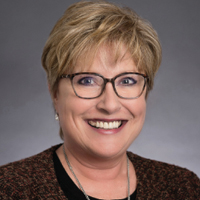Posted on Sep 28, 2018 in
FOCUS ON THE CURE

Robin Judman
Director of Operations,
Memorial Hermann
Outpatient Imaging –
Katy and MD Anderson
Breast Care with Memorial Hermann – Memorial City
Robin Judman and her colleagues know that when it comes to breast cancer, early detection offers the greatest opportunity for full recovery.
“A mammogram can identify lumps and other abnormalities long before they can be felt,” she said. “While we recommend annual screening begin at 40, women at a higher risk for the disease – those with a family history, genetic tendency or a previous breast cancer – should consult with their doctor about screening earlier.”
Judman is the Director of Operations for Memorial Hermann Outpatient Imaging – Katy and MD Anderson Breast Care with Memorial Hermann – Memorial City, part of the Memorial Hermann Health System, comprised of 26 imaging sites in Greater Houston, 17 of which include breast care centers. Memorial Hermann facilities are certified by the Mammography Quality Standards Act and accredited by the American College of Radiology and the Texas Mammography Accreditation Program. Board-certified breast radiologists from MD Anderson Cancer Center, in partnership with Memorial Hermann, interpret screenings and perform diagnostic procedures at many of the system’s centers.
Screening mammograms are most often administered to patients free of concerning symptoms, such as a lump in the breast, nipple discharge or changes in the size, shape, texture or color of breast skin. The exam generally consists of two standard images taken of each breast. Diagnostic mammograms are performed in response to the presence of one or more concerning symptoms and consist of additional, more focused images, allowing for more accurate and effective characterization of symptoms. Screening mammograms may be performed as either traditional 2-D mammograms or as 3-D mammograms.
While 2-D mammograms take two-dimensional images – one from above and one from the side of the breast – and are considered the gold standard of breast cancer screening, 3-D mammography allows radiologists to “see inside” the breast tissue and provide improved screening in particular for women with dense or fatty breast tissue. With 3-D mammography, cancer detection rates are increased by as much as 30 to 40 percent, with 30 to 40 percent fewer false positives.
Another advancement in breast cancer screening is the breast MRI, recommended for women in higher risk categories. Using magnets instead of X-ray radiation, breast MRIs deliver small, cross-sectional images of the breast. The procedure enables radiologists to examine more closely the soft tissue of the breast and may result in earlier detection of abnormalities in the structure of the breast, tissue damage or disease, inflammation, lumps and cancer.
“While breast MRIs can detect cancers not visible in traditional 2-D mammograms, they aren’t a substitute for regular mammograms,” Judman explained. Rather, she added, they are an additional tool to help diagnose cancer earlier.
“With statistics indicating that one in eight American women will be diagnosed with breast cancer, it’s never been more important to be screened regularly,” Judman said.
“Multiple studies indicate significantly reduced mortality due to breast cancer for women who undergo mammographic screenings compared to those who do not. Please call to schedule your mammogram today.”


 <
<






